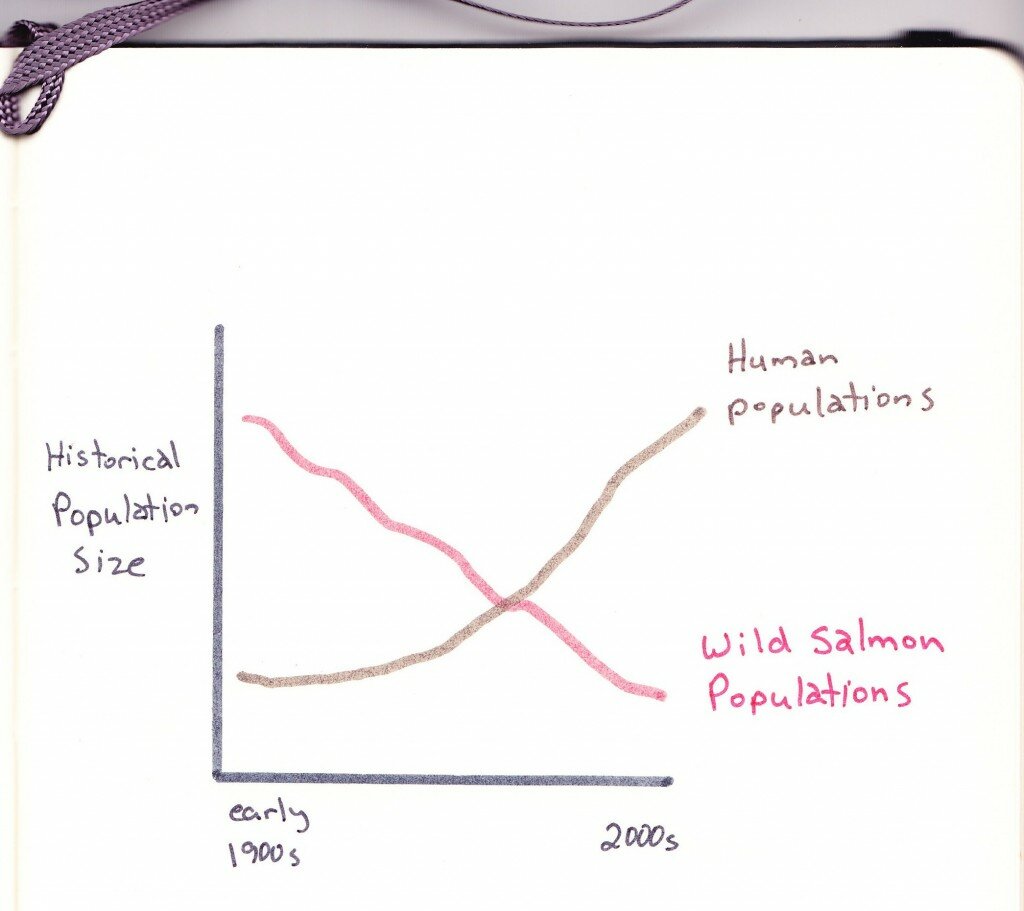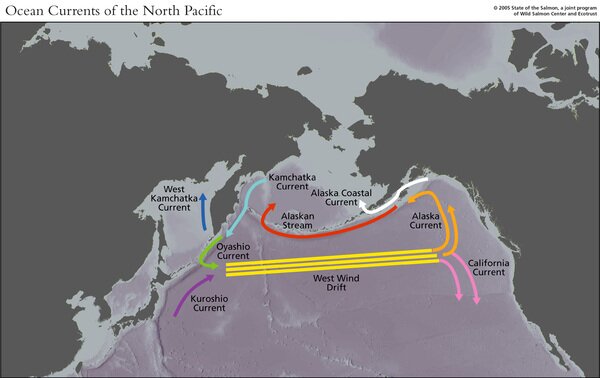State of the Salmon maps - Historical Range
In August I charted this highly advanced graph:
I’m certainly curious whether anyone has actually done any specific research on this topic (?)
Curiously, this type of research has been done on human-elephant interactions in Africa. Just the other day I came across this study and was quite surprised with the strong relationship with my graph from August.
.
The decline in the range and numbers of elephants as a result of expanding human activity in Africa is recognized as one of the continent’s most serious conservation problems. Understanding the relationship between human settlement patterns and elephant abundance is fundamental to predicting the viability of elephant populations.
Basically… humans and elephants do fine together up to a point — but… once human settlement reaches a certain density — no more elephants.
_ _ _ _ _
So what about salmon?
If you start looking at the map I started this post with… it probably starts to look this:
Hmmm… do you see a pattern maybe?
For example, 95% of Japan’s commercial salmon fisheries are based on salmon ranching efforts… not much left for wild stocks… not much room.
Seems like salmon are ‘done, near extinction‘ or in ‘big trouble‘ (technical terms) in the same places where human populations and density are expanding rapidly. Like California, for example, where there’s more people (35 million or so) then all of Canada, and more cars then people…
Great for movie making and highway building… not so good for water supplies; really bad for salmon range — really, really bad for salmon.
_ _ _ _ _
Was human density in relation to salmon populations one of the twelve “scientific” studies initiated by the Cohen Commission into declines of Fraser sockeye?
No…And fair enough…
But there is this federal government agency (with a hefty budget) that is responsible for looking into these things.
If salmon really, really mattered to governments — and the like — it’s probably something that should be looked at. There’s a heckuva lot more we can do about human settlement density (and it’s effluent) than we can about the North Pacific Gyre, or Aleutian Low, or those two pesky kids: El Nino and La Nina
Yet many scientists and researchers — who coincidentally earn their living from research — are lobbying hard for more research on the ocean environment and its effects on salmon…
Maybe resources could focus on things we can actually do something about… like freshwater habitat, for example.
Not to say ocean research doesn’t have it’s place… it’s just that we’re not going to find the “smoking gun” out there. It’s kind of big… and vast…
_ _ _ _ _
Are salmon as important to the people of the Pacific Rim as elephants are to Africa?
Is trying to understand the relationship between human settlement patterns and salmon abundance fundamental to predicting the viability of salmon populations?




Re: … many scientists and researchers — who coincidentally earn their living from research — are lobbying hard for more research on the ocean environment and its effects on salmon…”
It seems that science is the review of something that happened or is happening…
It’s not science but people who save salmon using ” resources [to] focus on things we can actually do something about… like freshwater habitat, for example.”
DFO people also earn their living from creating “escapement”. If DFO people could use resources to restore salmon and salmon habitat rather than create hatched “targets” (conservation?) then perhaps things could move ahead a little faster. Good post and check out in your spare time (as though you have any)
cheers
thanks for the link… have seen similar pieces — pretty neat. I think someone else has one using cat tails…
Yes, resources to the things we can actually do something about is a great idea. In the late 1990s the Habitat Conservation and Stewardship Program (HCSP) did some good work. $100 million over 5 years. Certainly wasn’t a perfect program, but set up some great networks and really encouraged the idea of stewardship.
$100 million for 5 years… one salmon life cycle… no monitoring of all the work done — not so great.
The follow-up to that program – PICFI. Pacific integrated commercial fisheries initiative. Great, another license buy-back program.
“capacity building”? for what? to count the last fish on a dieing run.
Everything flows downstream. simple concept. The situation in the upper Fraser — in regards to salmon — ain’t good. That is only going to flow downstream, soon enough.
Record runs this year? Not up here. Decent… but no records that I’ve heard of yet.
Estimates out of the U.S. suggest $1 billion annually on fish habitat restoration and reclamation… less than 10% of those projects are actually monitored to see if they’re working or even making a difference.
Looking after salmon cannot continue to be a throwing money, paper pushing, bumpf-producing exercise. It takes hands and feet in the creeks trying to improve the things we can actually improve. I mean hands and feet in the creek in a figurative sense when it comes to sewage and treatment plants — but much more work must be done up and down the Fraser on that front. The amount of waste pumped out of Vancouver alone is devastating.
Recent estimates of required upgrades? $1.5 billion.
See Simon Fraser University 2010 Sockeye Salmon Summit proceedings.
Fundamental restructuring of how we look after salmon is an absolute must.
In some of the work I do, if things are going really bad in a ‘management’ sense… something called “third-party management” occurs.
Maybe the institutions tasked with looking after salmon need some third-party management until things improve, paradigms shift, and assumptions change…?